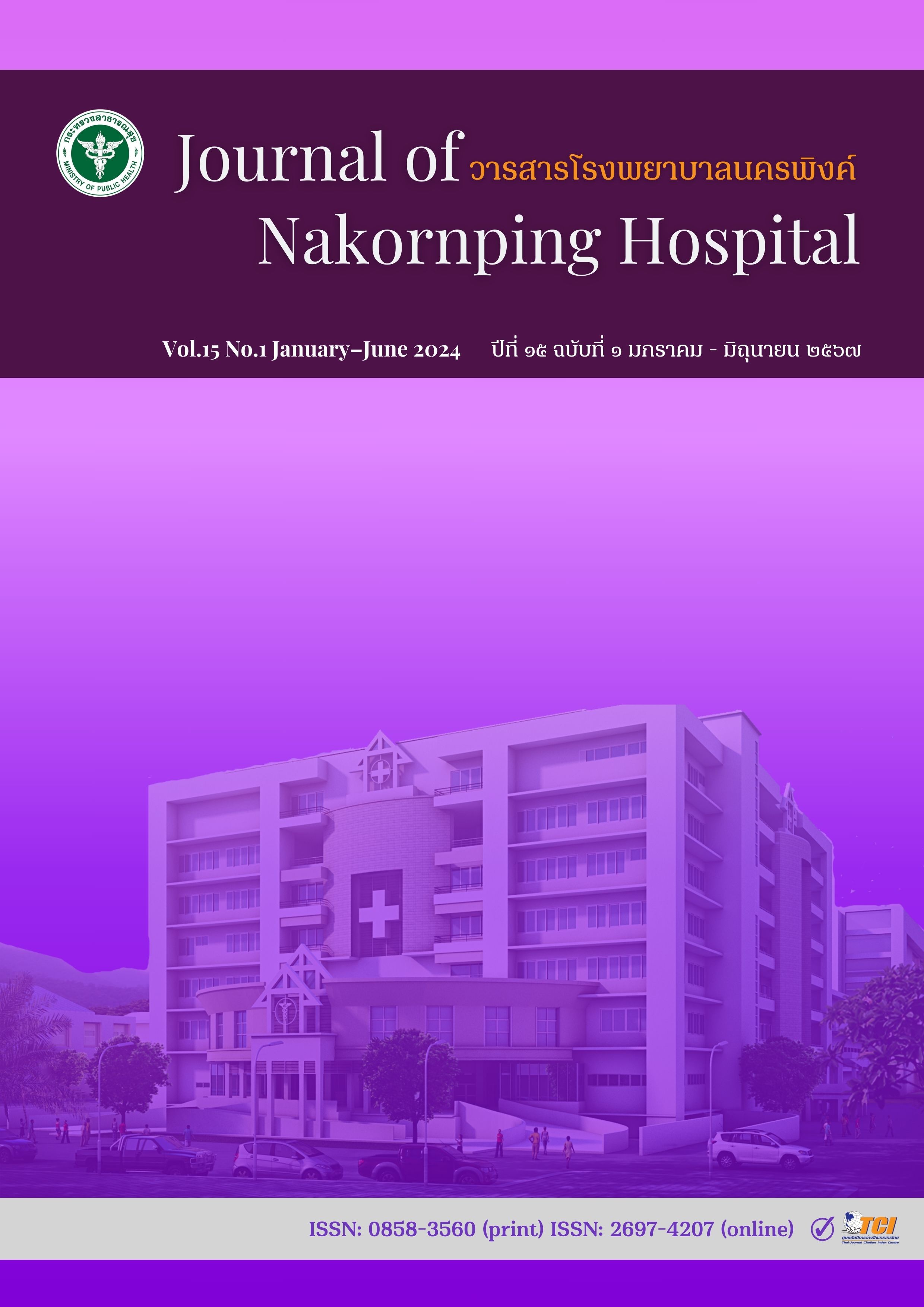ปัจจัยที่มีผลต่อการติดเชื้อโควิด-19 ของผู้ต้องขังในเรือนจำกลาง จังหวัดเชียงใหม่
คำสำคัญ:
การติดเชื้อไวรัสโควิด-19, ผู้ต้องขัง, จังหวัดเชียงใหม่, วัคซีน, การเข้าร่วมทำกิจกรรมบทคัดย่อ
ที่มา: โรคโควิด-19 (COVID-19) คือโรคติดต่ออุบัติใหม่ซึ่งเกิดจากเชื้อไวรัสโคโรนาสายพันธุ์ใหม่ 2019 พบการแพร่ระบาดและผู้ติดเชื้อจำนวนมากไปทั่วโลก การติดเชื้อไวรัสโควิด-19 ในเรือนจำ มีพื้นที่จำกัดในการอยู่อาศัย และมีประชากรจำนวนมาก การศึกษาปัจจัยที่มีผลต่อการติดเชื้อไวรัสโควิด-2019 สามารถช่วยในการป้องกันและควบคุมการติดเชื้อไวรัสโคโรนา 2019 ได้
วัตถุประสงค์ เพื่อศึกษาปัจจัยที่มีผลต่อการติดเชื้อไวรัสโควิด-19 ของผู้ต้องขังในเรือนจำกลางเชียงใหม่
วิธีการศึกษา การศึกษาเก็บข้อมูลย้อนหลัง (Retrospective study) ในเรือนจำกลางชาย ตั้งแต่วันที่ 1 มกราคม 2564 ถึง 31 ธันวาคม 2565 ในผู้ต้องขังเรือนจำกลางเชียงใหม่อายุ 18 ปีขึ้นไป จำนวน 400 คน ทำการสุ่มตัวอย่างแบบง่าย การวิเคราะห์ข้อมูลด้วยวิธี Logistic regression analysis
ผลการศึกษา จำนวนกลุ่มตัวอย่าง 400 ราย ติดเชื้อไวรัสโควิด-19 342 ราย (ร้อยละ 85.5) ปัจจัยด้านกลุ่มอายุ จำนวนวัคซีนป้องกันโรคติดเชื้อไวรัสโควิด-19 ที่ได้รับ การเข้าร่วมทำกิจกรรมต่างๆประจำวัน และการทำความสะอาดที่พักอาศัย มีความแตกต่างกันในกลุ่มที่ติดและไม่ติดเชื้อไวรัสโควิด-19 เมื่อวิเคราะห์ด้วยสมการถดถอยแบบตัวแปรพหุ พบว่า จำนวนวัคซีนป้องกันโรคติดเชื้อไวรัสโควิด-19 ที่ได้รับ2 เข็ม (Adjusted OR = 20.312, 95% CI 4.464 - 92.418) การเข้าร่วมทำกิจกรรมต่างๆประจำวัน (Adjusted OR = 4.261, 95% CI 2.217 - 8.187) และการทำความสะอาดที่พักอาศัยน้อยกว่า 4 ครั้งต่อเดือน (Adjusted OR = 2.917, 95% CI 1.501 - 5.669) มีความสัมพันธ์กับการติดเชื้อไวรัสโควิด-19ในผู้ต้องขังเรือนจำกลางเชียงใหม่ อย่างมีนัยสำคัญทางสถิติ (p-value < 0.05)
สรุปผล การส่งเสริมให้มีการได้รับวัคซีนเข็มกระตุ้นของผู้ต้องขังในเรือนจำ และการรณรงค์มาตรการป้องกันตนเองจากการติดเชื้อโควิด-19 เช่น ทำความสะอาดที่พักอาศัยอย่างสม่ำเสมอ สามารถลดการติดเชื้อในประชากรที่อยู่แออัดได้
เอกสารอ้างอิง
Singhal T. A review of Coronavirus Disease-2019 (COVID-19). Indian J Pediatr. 2020;87(4):281-6. doi: 10.1007/s12098-020-03263-6.
Sharma A, Ahmad Farouk I, Lal SK. COVID-19: A review on the Novel Coronavirus disease evolution, transmission, detection, control and prevention. Viruses. 2021;13(2):202. doi: 10.3390/v13020202.
Richards F, Kodjamanova P, Chen X, Li N, Atanasov P, Bennetts L, et al. Economic Burden of COVID-19: A systematic review. Clinicoecon Outcomes Res. 2022;14:293-307. doi: 10.2147/CEOR.S338225.
World Health Organization. COVID-19 epidemiological update – 22 December 2023 [Internet]. Switzerland: World Health Organization; c2023 [update 2023 Dec 22; cited 2023 Dec 31]. Available from: https://www.who.int/publications/m/item/covid-19-epidemiological-update---22-december-2023.
World Health Organization. Coronavirus (COVID-19) Dashboard [Internet]. Switzerland: World Health Organization; c2022. [cited 2023 Dec 31]. Available from: https://covid19.who.int/
Parasher A. COVID-19: Current understanding of its pathophysiology, clinical presentation and treatment. Postgrad Med J. 2021;97(1147):312-20. doi: 10.1136/postgradmedj-2020-138577.
Zhu Y, Sharma L, Chang D. Pathophysiology and clinical management of coronavirus disease (COVID-19): a mini-review. Front Immunol. 2023;14:1116131. doi: 10.3389/fimmu.2023.1116131.
Mahendra M, Nuchin A, Kumar R, Shreedhar S, Mahesh PA. Predictors of mortality in patients with severe COVID-19 pneumonia - a retrospective study. Adv Respir Med. 2021;89(2):135-44. doi:10.5603/ARM.a2021.0036.
Department of corrections. Covid-19 situation in prisons From 1 April 2021 [Internet]. Nonthaburi: Department of corrections; c2018 [update 2022 Jun 3; cited 2022 Jun 5]. Available from: http://www.correct.go.th/?p=104381 [In Thai]
Crowley D, Cullen W, O'Donnell P, Van Hout MC. Prison and opportunities for the management of COVID-19. BJGP Open. 2020;4(3):bjgpopen20X101106. doi: 10.3399/bjgpopen20X101106.
Esposito M, Salerno M, Di Nunno N, Ministeri F, Liberto A, Sessa F. The risk of COVID-19 infection in prisons and prevention strategies: a systematic review and a new strategic protocol of prevention. Healthcare (Basel). 2022;10(2):270. doi: 10.3390/healthcare10020270.
Huang C, Yang L, Pan J, Xu X, Peng R. Correlation between vaccine coverage and the COVID-19 pandemic throughout the world: Based on real-world data. J Med Virol. 2022;94(5):2181-7. doi: 10.1002/jmv.27609.
Narongtanupol P, Narongtanupol P. Immune response after receiving Covid-19 vaccination. Academic Journal of Community Public Health. 2022;8(4):178-94. [In Thai]
Polack FP, Thomas SJ, Kitchin N, Absalon J, Gurtman A, Lockhart S, et al. Safety and efficacy of the BNT162b2 mRNA Covid-19 Vaccine. N Engl J Med. 2020;383(27):2603-15. doi: 10.1056/NEJMoa2034577.
Ssentongo P, Ssentongo AE, Voleti N, Groff D, Sun A, Ba DM, et al. SARS-CoV-2 vaccine effectiveness against infection, symptomatic and severe COVID-19: a systematic review and meta-analysis. BMC Infect Dis. 2022;22(1):439. doi: 10.1186/s12879-022-07418-y.
Yang ZR, Jiang YW, Li FX, Liu D, Lin TF, Zhao ZY, et al. Efficacy of SARS-CoV-2 vaccines and the dose-response relationship with three major antibodies: a systematic review and meta-analysis of randomised controlled trials. Lancet Microbe. 2023;4(4):e236-46. doi: 10.1016/S2666-5247(22)00390-1.
Chirico F, Teixeira da Silva JA, Tsigaris P, Sharun K. Safety & effectiveness of COVID-19 vaccines: A narrative review. Indian J Med Res. 2022;155(1):91-104. doi: 10.4103/ijmr.IJMR_474_21.
Lu PJ, Srivastav A, Vashist K, Black CL, Kriss JL, Hung MC, et al. COVID-19 booster dose vaccination coverage and factors associated with booster vaccination among adults, United States, March 2022. Emerg Infect Dis. 2023;29(1):133-40. doi: 10.3201/eid2901.221151.
Menni C, May A, Polidori L, Louca P, Wolf J, Capdevila J, et al. COVID-19 vaccine waning and effectiveness and side-effects of boosters: a prospective community study from the ZOE COVID Study. Lancet Infect Dis. 2022;22(7):1002-10. doi: 10.1016/S1473-3099(22)00146-3.
Liu C, Huang J, Chen S, Wang D, Zhang L, Liu X, et al. The impact of crowd gatherings on the spread of COVID-19. Environ Res. 2022;213:113604. doi: 10.1016/j.envres.2022.113604.
Khosravizadeh O, Ahadinezhad B, Maleki A, Najafpour Z, Golmohammadi R. Social distance capacity to control the COVID-19 pandemic: A systematic review on time series analysis. Int J Risk Saf Med. 2022;33(1):5-22. doi: 10.3233/JRS-210037.
VoPham T, Weaver MD, Hart JE, Ton M, White E, Newcomb PA. Effect of social distancing on COVID-19 incidence and mortality in the US. medRxiv [Preprint]. 2020:2020.06.10.20127589. doi:10.1101/2020.06.10.20127589.
Manikandan N. Are social distancing, hand washing and wearing masks appropriate measures to mitigate transmission of COVID-19?. Vacunas. 2020;21(2):136-7. doi: 10.1016/j.vacun.2020.09.001.
Chia PY, Coleman KK, Tan YK, Ong SWX, Gum M, Lau SK, et al. Detection of air and surface contamination by SARS-CoV-2 in hospital rooms of infected patients. Nat Commun. 2020;11(1):2800. doi: 10.1038/s41467-020-16670-2.
Chu DT, Singh V, Vu Ngoc SM, Nguyen TL, Barceló D. Transmission of SARS-CoV-2 infections and exposure in surfaces, points and wastewaters: A global one health perspective. Case Stud Chem Environ Eng. 2022;5:100184. doi: 10.1016/j.cscee.2022.100184.
Tina C. Reducing COVID-19 transmission through cleaning and disinfecting household surfaces [Internet]. Vancouver, BC: National Collaborating Centre for Environmental Health; c2020 [update 2020 Apr 28; cited 2024 Jan 1]. Available from: https://ncceh.ca/resources/evidence-reviews/reducing-covid-19-transmission-through-cleaning-and-disinfecting
ดาวน์โหลด
เผยแพร่แล้ว
รูปแบบการอ้างอิง
ฉบับ
ประเภทบทความ
สัญญาอนุญาต
ลิขสิทธิ์ (c) 2024 โรงพยาบาลนครพิงค์

อนุญาตภายใต้เงื่อนไข Creative Commons Attribution-NonCommercial-NoDerivatives 4.0 International License.
บทความที่ได้รับการตีพิมพ์เป็นลิขสิทธิ์ของโรงพยาบาลนครพิงค์ จ.เชียงใหม่
ข้อความที่ปรากฏในบทความแต่ละเรื่องบทความในวารสารวิชาการและวิจัยเล่มนี้เป็นความคิดเห็นส่วนตัวของผู้เขียนแต่ละท่านไม่เกี่ยวข้องกับโรงพยาบาลนครพิงค์ และบุคลากรท่านอื่นๆในโรงพยาบาลฯ ความรับผิดชอบเกี่ยวกับบทความแต่ละเรื่องผู้เขียนจะรับผิดชอบของตนเองแต่ละท่าน



